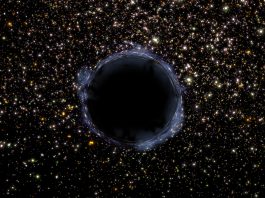Researchers have discovered that a previously unidentified ‘bright burst’ is in fact a fast blue optical transient located in a tiny galaxy 500 million lightyears away.
In 2016, astronomers visually spotted a bright burst in space, however this anomaly was not identified until a recent study led by Northwestern University discovered that the burst of light is a fast blue optical transient located in a tiny galaxy 500 million lightyears away.
What are fast blue optical transients?
Fast blue optical transients are a type of cosmic explosion initially detected in the optical wavelength. So hot that they glow blue, fast blue optical transients reach peak brightness within a matter of days and then quickly fade – much faster than standard supernovae rise and decay. Although astronomers recognised fast blue optical transients as their own class in 2014, they assume these anomalies have been appearing in space for much longer.
“These have probably been inside our archives for a long time, but we didn’t recognise them as anything different,” Margutti said. “We saw glitches in other galaxies that we couldn’t explain. But we couldn’t get information outside the optical wavelength, so we couldn’t examine them further. We would just call them ‘weird supernovae’.”
Fast blue optical transients often surprise astronomers with their fast, energetic, powerful bursts of energy. As their name implies, transients fade almost as quickly as they appear. Perhaps the most famous fast blue optical transient is AT2018COW (‘The Cow’) – a rare event that appeared to be the birth of a black hole or a neutron star. However, the newly identified FBOT, called CRTS-CSS161010 J045834-081803 or CSS161010 for short, has vastly overshadowed ‘The Cow’ with the sheer speeds and heaviness of its material outflows.
CSS161010 has produced some of the fastest outflows in nature, launching gas and particles at more than 55% the speed of light. “This was unexpected. We know of energetic explosions that can eject material at almost the speed of light, specifically gamma ray bursts, but they only launch a small amount of mass – about one millionth the mass of the sun.
“CSS161010 launched one to ten percent the mass of the sun at more than half the speed of light — evidence that this is a new class of transient,” said Northwestern’s Deanne Coppejans, who is first author of the study.
The home of CSS161010
Before astronomers spotted CSS161010, they had not noticed the tiny galaxy in which it resided. The bright fast blue optical transient drew attention to a dwarf galaxy near the constellation Eridanus. The host galaxy contains about 10 million stars, whereas the Milky Way comprises billions. With remote access to the Keck telescopes, Hawaii, the Northwestern researchers were able to view the tiny galaxy, which looked like nothing more than a small speck.
So far, astronomers have only found bright fast blue optical transients like CSS161010 and the Cow in these tiny galaxies, which gives a clue into their nature. Although Margutti and Coppejans have not yet fully explored this, they speculate that tiny galaxies might be more likely to harbour transients because these galaxies contain such low levels of metals.
The amount of metals affects how much mass stars lose throughout their lifetimes in the form of stellar wind. A star without metals can potentially retain more of its mass, producing a bigger explosion at the end of its life.
“Every time a star dies or neutron stars merge, they give metals back to the environment. Tiny galaxies have a tiny amount of metals because not many stars have died there. This has an impact on how other stars live their lives. We believe that it’s not by chance that we only find these very rare transients in these tiny galaxies,” said Giacomo Terreran, a postdoctoral associate at CIERA.









